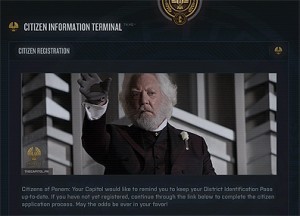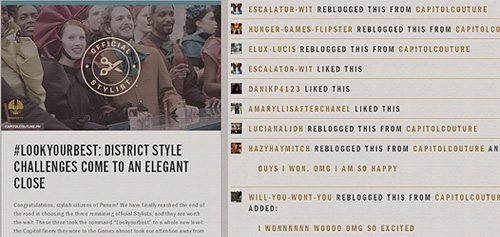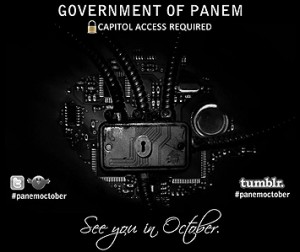Creating a Spark: Official and Fan-Produced Transmedia for The Hunger Games
 The Hunger Games (THG) has become one of Hollywood’s biggest success stories of the year. Since the film is based on a successful young adult novel by Suzanne Collins, the cinematic adaptation could count on a built-in audience. In order to mobilize the existing fan base and court new fans, Lionsgate’s marketing department rolled out a campaign that incorporated transmedia storytelling elements. The centerpiece of the campaign is an ARG (Alternate Reality Game) that allows fans to become citizens of Panem. Accessible through the “Citizen Information Terminal,” a website that aggregates content from Facebook, Tumblr, Twitter, and Youtube, the ARG mixes diegetic information (such as trends in Capitol fashion) with extradiegetic material (e.g. a link to Fandango, accompanied by a note declaring that “attendance [of the film] is mandatory”).
The Hunger Games (THG) has become one of Hollywood’s biggest success stories of the year. Since the film is based on a successful young adult novel by Suzanne Collins, the cinematic adaptation could count on a built-in audience. In order to mobilize the existing fan base and court new fans, Lionsgate’s marketing department rolled out a campaign that incorporated transmedia storytelling elements. The centerpiece of the campaign is an ARG (Alternate Reality Game) that allows fans to become citizens of Panem. Accessible through the “Citizen Information Terminal,” a website that aggregates content from Facebook, Tumblr, Twitter, and Youtube, the ARG mixes diegetic information (such as trends in Capitol fashion) with extradiegetic material (e.g. a link to Fandango, accompanied by a note declaring that “attendance [of the film] is mandatory”).
Transmedia storytelling has become a familiar element of film and television promotion, especially for media properties incorporating fantasy and scifi elements (currently, transmedia campaigns are underway for Prometheus, The Amazing Spider-Man, and The Dark Knight Rises). While many fans readily engage with official promotional material, they also create their own media. Transmedia produced for THG shows how multifaceted and sometimes conflicting interests among fans and marketing departments arise out of shared media platforms and a shared storyworld.
With the widespread use of Twitter and Tumblr, official and fan-produced transmedia increasingly share the same media spaces. Both fans and those who address fans through marketing use these spaces because they make sharing media easy. Indeed, sharing images and videos via reblogging is perhaps Tumblr’s core functionality and defining characteristic. Via reblogging and retweeting, fans spread news about the latest part of a marketing campaign faster and wider than a print ad, poster, or traditional preview could. Most importantly, reblogging turns officially produced transmedia into a personalized message: fans feel they receive an update about THG from a fellow fan, not from a studio’s marketing department. Or at least this is the perception that marketing departments try to create.
It is important to recognize that both Lionsgate’s marketing department and fans face constraints when producing transmedia for THG. Official transmedia’s main purpose is twofold: create interest in THG and persuade as many people as possible to purchase a ticket to see the film. In order to create this investment, official transmedia has to offer material about the world of THG that appears new and exciting to fans; at the same time, this material cannot give away too many details about the film itself. This is particularly crucial for a book adaptation because many fans are familiar with the story and are most interested in seeing how this story has been translated to the screen. In addition, official transmedia cannot stray too far from “canon.” It has to remain faithful to the story moviegoers will see. Working within these constraints leads to transmedia elements that focus on exploring places and settings rather than on expanding plot or characterizations.
Two core elements of THG transmedia campaign, namely the Capitol Couture Tumblr and the related virtual tour of the Capitol, focus on the culture of Panem’s premiere city. Both are perfect examples of official transmedia that provide new insights about the world of THG without spoiling the film or diverging from Collins’ canon. While the Capitol is an important location in THG‘s storyworld, neither the film nor the novel spend much time there. Offering a deeper insight into the city expands fans’ understanding of Panem without giving too much away. At the same time, a campaign that centers on the people and culture responsible for the terror of the Hunger Games is also a risky strategy. Fans might not have been willing to engage with this aspect of the book(s) and film. But the Capitol also appears as a decadent and alluring place in Collins’ universe, which makes it an interesting place to see even if one disagrees with its ideology.
Additionally, I would argue, fans can easily find the more sympathetic people and places of THG in fan-produced transmedia. Free from the constraints of avoiding spoilers and adhering to canon, most fanfiction and fanart delve into the lives of central characters, envisioning moments before, during, and after canon events. Fan creations spread across the same platforms as official transmedia: a new interpretation of a character might emerge in a tweet, turn into a story posted on a blog, and generate accompanying fanart on Tumblr.
Of course fans also face constraints: their creations are not officially sanctioned and often exist in a legal gray area, and they don’t usually have access to the resources that fuel official transmedia such as the Capitol tour. Frequently, these divergent sets of constraints in official and fan-produced transmedia enable new and largely complementary perspectives on the world of THG. This co-existence is less harmonious when fan productions appear too “official,” as was the case with Panem October, a fan-authored ARG that also revolved around a “citizens of Panem” theme. An early iteration, launched in spring 2011, was shut down by Lionsgate. The second version appeared simultaneously with the official ARG last fall. Thanks to fannish word-of-mouth, participation in Panem October grew to 50,000. Despite its popularity, the creator announced last December that he was abandoning the ARG to pursue other projects. It is unclear whether or not increasing pressure by Lionsgate motivated this decision.
It is tempting to draw parallels between Panem October and THG trilogy’s overall story (a temptation the pursuit of which I leave to someone else). Regardless, it seems apparent to me that fan enthusiasm is most welcome when it stays within officially endorsed boundaries—as participation in the official THG ARG—and is tolerated as long as its focus does not encroach on commercially significant territory.






Great article Melanie. The goal of the Transmedia strategy of the production is well analysed : building a community and making the fans discover something they haven’t seen / read before, the Capitol.
Indeed, the fans encounter some legal issues with Lionsgate. You talk about the fan-made ARG that had to be shut down. But there is also the “hunger is not a game” activist campaign that was sut down also. It was created by the Harry Potter Alliance, the Hunger Games’ fans in collaboration with Oxfam to explain the danger of hunger to young adults.
Thank you for your comment! Can you tell me more about the HP Alliance campaign? It doesn’t sound like it had much to do with the film, so I’m surprised to hear that Lionsgate felt the need to shut it down.
Writing this post, I’ve also come to the realization that perhaps studios don’t entirely understand that fans are happy to go along with multiple iterations of the same plot or concept (after all, that is what fanart and fanfiction is all about). Fans participated in both the fan-made and the official Hunger Games ARG, for example. Where studios might see competition, fans see multiplicity.
In the case of the Oxfam “Hunger is Not a Game” campaign, it was more about trademarks as opposed to copyright, and Lionsgate eventually relented…however, this is a recurring trend with fan creations.
Every now and then, agencies will champion unfettered works, like when Deep Focus helped bring back the unofficial Mad Men twitter accounts. However, the C&Ds and DMCA complaints keep flowing.
Thank you for the clarification and additional example. I find it fascinating to watch the media industry oscillate between wanting fans to engage and panicking when fans really do engage by moving beyond the boundaries laid out by content creators.
I was listening to Henry Jenkins’ talk in London and he just talked about The Hunger is not a game campaign. Apparently Lionsgate sent cease letters to the fans, asking them to shut it down. Fans published the letters on blogs acirculating it and signing a petition. Facing fans’ response, Lionsgate backed down and joined fans in their campaign.
Thanks for letting me know about this! I think some of his recent talks were taped and put online, so hopefully he’ll bring up the example in the taped lecture as well.
Great post, and it raises some important points about the increased slippage between “official” and fan-produced transmedia texts, both in terms of scope/style and how these materials circulate. I especially like your point here about how something as simple as reblogging on tumblr can recontextualize promotional content, pulling it into personalized fan networks. It’s another question/point of contention when texts from within those personalized fan networks get pulled into official promotional spaces. I think you’re spot on when you suggest that fan enthusiasm is welcome only within clearly demarcated boundaries that the industry constructs (but can’t realistically maintain), but there’s also something to be said here about the boundaries that fans construct around their own content and its use. Tumblr is so circulation-oriented, and growing so rapidly as a fan platform, I would be interested to hear more about what you think of it in the context of this cross-pollination of transmedia content.
Something else that struck me while reading this- there’s probably no way to quantify this, but I wonder to what extent the large number of Capitol cosplayers at various premieres/midnight screenings of the film can be credited to the transmedia promotional paratexts’ emphasis on Capitol Couture and culture. There’s something perversely fitting about the studio latching on to the Capitol as the cornerstone of its campaign…but conceptually smart, for all the reasons you list above.
Thank you, Suzanne! There is so much more to say about this campaign. I’ve been thinking about Tumblr a lot lately because it is all public and it makes the circulation of content so easily. Tumblr’s infrastructure can make it difficult to trace the origin of a post, which helps to blur further the boundaries between official and fan-created material. I also wonder if fans who come into fandom via Tumblr are as concerned about protecting fannish spaces as fans who experienced fandom in other spaces first.
Yes, I wonder if there was a connection! I also think that the crazy Capitol fashion lends itself most to cosplay, which might also be a motiviating factor. I was rather surprised when I saw that the official transmedia campaign was designed around the Capitol. It made me wonder if the studio thought through any parallels one might draw between them and the position the Capitol occupies in the Hunger Games diegesis.
[…] on Like this:LikeBe the first to like this […]